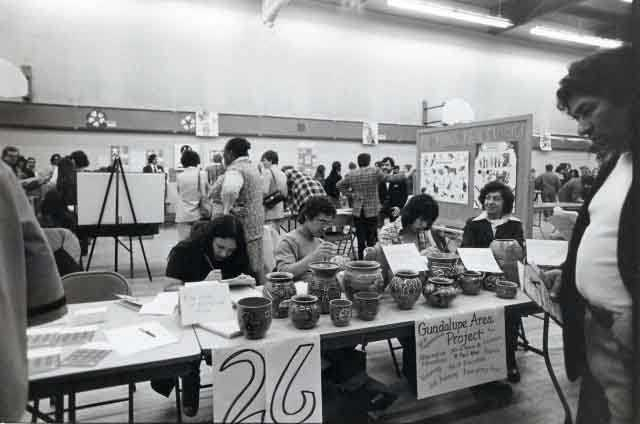During the 1960s, as the nation was experiencing a civil rights movement for African Americans, Mexican Americans were inspired to bring change to their own communities. They created the term Chicano to show a sense of pride, express resistance, and strengthen cultural identity. It was first used in Southern California and Texas, where Cesar Chavez, Dolores Huerta, and the United Farm Workers were uniting figures. Their political and social work came to be known as the Chicano Movement, or El Movimiento.
Mexican and Mexican American migration to the Midwest dates to the 1920s and 1930s, when laborers moved to the north to work on sugar beet farms. Over time, they set down roots in Minnesota communities — particularly St. Paul’s Lower West Side (the West Side Flats), which offered jobs in meatpacking and the railroad industry. Towards the end of the 1930s, so many Mexicans tried to settle near their families that there was a housing shortage in the neighborhood.
Much of the housing on the Lower West Side was eventually considered uninhabitable due to the area’s high risk of flooding. A flood in 1952 caused 2,641 residents to evacuate, and a second flood in 1957 emphasized a need for a long-term solution. The neighborhood had already become a target for urban renewal, and the St. Paul Port Authority had announced in 1956 that the Riverview Industrial District project would demolish the community. Families were reluctant to leave their homes, stores, schools, and churches, even though they were promised jobs in Riverview. The city completed the project in 1964 at a cost of $9 million for the construction and $4 million for relocation costs, but the jobs didn’t come in the quantity promised.
As a result of losing a section of their neighborhood, Mexicans and Mexican Americans took inspiration from the Chicano cultural movement happening throughout the United States. Some groups, including the U.S. government and southwestern Chicanos, disparaged the Midwesterners. The latter called them “culturally deprived” and claimed that they “didn’t know what it meant to be Chicano.” The comments, however, did not derail Chicanos in Minnesota, and they continued to seek connections and advice.
Sister Mary Giovanni Gourhan, a Westside St. Paul native active in Our Lady of Guadalupe Church, resolved to help her community specifically through education. In 1966, she came up with the idea of the Guadalupe Area Plan, also known as GAP. GAP was designed to fill the opportunity gap between Latino people and other groups through alternative education classes. The program admitted fourteen to nineteen-year-old students on probation or parole as well as those having difficulty in school.
GAP’s general school courses integrated Mexican history, culture, and tradition, creating an immersive experience for students intended to inspire pride in their work. They also built foundational skills for students to seek employment to provide for their families. By 1967, Gourham’s dream had become a reality, and GAP was a mainstay in the community. (In 2019, GAP continues to assist at-risk students via the St. Paul school system.)
In 1967, the Brown Berets, a pro-Chicano group, formed on the East Side of Los Angeles. Their objectives were to address police harassment, improve education, and increase political representation. A chapter was created in St. Paul in 1969. St. Paul’s Brown Berets served their community by raising funds for families in need, providing legal aid, and assisting the Guadalupe Area Plan by transporting craft goods.
There was also a push for Chicano history to be taught at the university level. In 1969, the University of California Santa Barbara’s Chicano Coordinating Council on Higher Education crafted a “Plan de Santa Bárbara” — a call to action to increase Latino recruitment, admission, representation, and programming in higher education. The Latin Liberation Front (LLF), a student group at the University of Minnesota, formed in 1970. On Oct. 26, 1971, LLF students led by Ramona Rosales took over Morrill Hall and demanded that a Chicano Studies Department be created. The College of Liberal Arts agreed, and the first Chicano studies classes were held in the fall of 1972.
For more information on this topic, check out the original entry on MNopedia.

